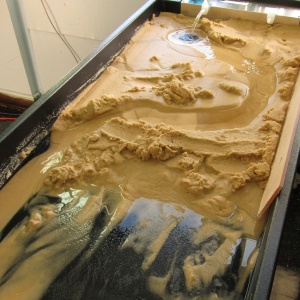Tags
3D Printing, 3dtin.com, Brooklyn, Civil Engineering, Earth Science, MakerBot, NYUPoly, STEM, Tinker
Last November my students began a culminating project on erosion to conclude a second grade unit on Earth materials. We used the MakerBot to fabricate small buildings to be placed on the banks of a model river.
The river model demonstrates water’s ability to change the surface of the earth. I made the project more interesting by adding the buildings to the river. This way the children could see the impact that erosion can have on humans.
The children used 3dtin.com to create their buildings. This is a free web-based 3D modeling program. The children were limited to creating their buildings with simple cubes. This constraint was caused by my inability to get WebGL/Chrome to work on our school laptops. This was a good limitation for their first foray into 3D modeling, but I would like to resolve this issue for our next project. Once I resolved, the students will be able to place a variety of shapes in their models(spheres, cones, text, etc).
A small number of students in each class took to the drafting program immediately. A majority of the children needed several 45 min periods of time on the program and some coaching from me. Each class had a few students(1-3) who were unable to create a printable building. Printing was an ongoing task. Each building took between 1-2 hours to print. The video below shows MakerBot printing.
After we had most of the buildings printed, we ran the test. Students decided where to place the buildings near the river in a pre flood state. After all the buildings were placed I caused a flood by dumping extra water at the source and increasing the flow of the pump. Students observed the river for about 5 minutes. They also viewed a time lapse video of the river that condensed 1 hour into about 3 minutes. Here is that video:
After conducting the test and viewing the video students completed a worksheet and rubric(03c-RiverErosionRubric) on their building.
The children really enjoyed this project. Now I need to think of our next MakerBot infused project.
This work was made possible by the NYUPoly Center for K-12 STEM Education, MakerBot Industries, PS 3 The Bedford Village School, and 3dtin.com.






Pingback: Aiden's House - Sense 3D Printer
Adding a compass rose to the sandbox could have been another interesting data point for students to notice and collect. What direction did the structure face before and after the flood? Awesome project.
Hi Mr. B,
Great idea! We could have one of the younger students design it.